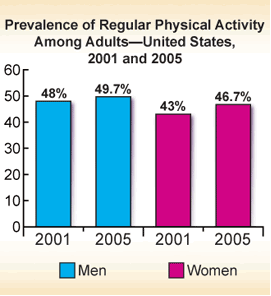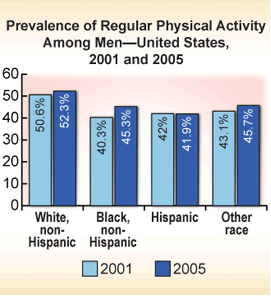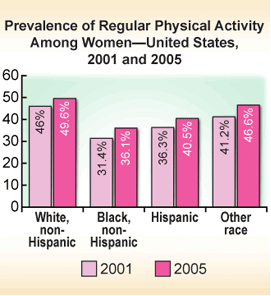Other Features
Featured Data & Statistics



Prevalence of Regular Physical Activity Among Adults – United States, 2001 and 2005
Regular physical activity is associated with decreased risk for obesity, heart disease, hypertension, diabetes, certain cancers, and premature mortality (1). CDC and the American College of Sports Medicine recommend that adults engage in at least 30 minutes of moderate physical activity on most days and preferably on all days (2). Healthy People 2010 objectives include increasing the proportion of adults who engage regularly in moderate or vigorous activity to at least 50% (objective 22-2). In addition, reducing racial and ethnic health disparities, including disparities in physical activity, is an overarching national goal (3). To examine changes in the prevalence of regular, leisure-time, physical activity from 2001 to 2005, CDC analyzed data from the Behavioral Risk Factor Surveillance System (BRFSS). This report summarizes the results of that analysis, which indicated that, from 2001 to 2005, the prevalence of regular physical activity increased 8.6% among women overall (from 43.0% to 46.7%) and 3.5% among men (from 48.0% to 49.7%). In addition, the prevalence of regular physical activity increased 15.0% (from 31.4% to 36.1%) among non-Hispanic black women and 12.4% (from 40.3% to 45.3%) among non-Hispanic black men, slightly narrowing previous racial disparities when compared with increases of 7.8% (from 46.0% to 49.6%) for white women and 3.4% (from 50.6% to 52.3%) for white men, respectively. CDC, state and local public health agencies, and other public health partners should continue to implement evidence-based, culturally appropriate initiatives to further increase physical-activity levels among all adults, with special focus on eliminating racial/ethnic disparities.
BRFSS is a state-based, random-digit--dialed telephone survey of the noninstitutionalized, U.S. civilian population aged >18 years. Data for this report were reported by the 50 states, District of Columbia, Puerto Rico, and U.S. Virgin Islands. CDC collected data for the 2001 BRFSS survey from 205,140 respondents (median response rate*: 51.1%; median cooperation rate†: 52.7%) and the 2005 survey from 356,112 respondents (median response rate: 51.1%; median cooperation rate 75.1%) (4). Response rates were calculated using guidelines from the Council of American Survey and Research Organizations.
Beginning in 2001, BRFSS included biannual questions about participation in moderate and vigorous physical activities. To assess participation in moderate activities, respondents were asked if, when not working, they "do moderate activities for at least 10 minutes at a time, such as brisk walking, bicycling, vacuuming, gardening, or anything else that causes some increase in breathing or heart rate" in a usual week. Respondents who answered "yes" were asked how many days per week they engaged in moderate activities and the amount of time spent in activities on each of those days. To assess participation in vigorous activities, respondents were asked to report whether they "do vigorous activities for at least 10 minutes at a time, such as running, aerobics, heavy yard work, or anything else that causes large increases in breathing or heart rate" in a usual week, when not working. Respondents who answered "yes" were asked how many days per week they engaged in vigorous activities and the amount of time spent in activities on each of those days. For this report, respondents considered to be engaging in regular physical activity were those who met the Healthy People 2010 objective of at least 30 minutes a day of moderate-intensity activity on 5 or more days a week, or at least 20 minutes a day of vigorous-intensity activity on 3 or more days a week, or both. Data were age adjusted to the 2000 U.S. standard population and weighted to provide overall estimates; 95% confidence intervals and p-values were calculated. Statistically significant changes in prevalence from 2001 to 2005 were determined by t-test (p<0.05).
From 2001 to 2005, the prevalence of regular physical activity increased by 8.6% (from 43.0% to 46.7%) among women overall and by 3.5% (from 48.0% to 49.7%) among men. Among women, significant increases in regular activity were observed in all racial/ethnic, age, and education-level categories examined with the exception of women aged 18--24 years. Among men, significant increases in regular physical activity were observed among respondents aged 45--64 years, non-Hispanic whites, non-Hispanic blacks, high school graduates, and college graduates.
Among racial/ethnic groups, significant increases in the prevalence of regular physical activity from 2001 to 2005 were observed among non-Hispanic black women (15.0%, from 31.4% to 36.1%), non-Hispanic black men (12.4%, from 40.3% to 45.3%), Hispanic women (11.6%, from 36.3% to 40.5%), women of other races (13.1%, from 41.2% to 46.6%), non-Hispanic white women (7.8%, from 46.0% to 49.6%), and non-Hispanic white men (3.4%, from 50.6% to 52.3%).
Despite certain gains, racial/ethnic disparities in physical activity remained evident in the 2005 survey results. Among men, non-Hispanic whites had the highest prevalence of regular physical activity (52.3%), followed by men classified as of other race (45.7%), non-Hispanic blacks (45.3%), and Hispanics (41.9%). Among women, non-Hispanic whites had the highest prevalence of regular physical activity (49.6%), followed by women classified as of other race (46.6%), Hispanics (40.5%), and non-Hispanic blacks (36.1%).
References
1. US Department of Health and Human Services. Physical activity and health: report of the Surgeon General. Atlanta, GA: US Department of Health and Human Services, CDC; 1996.
2. Pate RR, Pratt M, Blair SN, et al. Physical activity and public health: a recommendation from the Centers for Disease Control and Prevention and the American College of Sports Medicine. JAMA 1995;273:402--7.
3. CDC. DATA2010: the Healthy People 2010 database. Available at http://wonder.cdc.gov/data2010.
4. CDC. 2001 and 2005 BRFSS summary data quality reports. Atlanta, GA: US Department of Health and Human Services, CDC; 2002 and 2006. Available at http://ftp.cdc.gov/pub/data/brfss/2001summarydataqualityreport.pdf and http://ftp.cdc.gov/pub/data/brfss/2005summarydataqualityreport.pdf.
Source:
Centers for Disease Control and Prevention. Prevalence of Regular Physical Activity Among Adults – United States, 2001 and 2005. MMWR 2007; 56(46);1209-1212.
For More Information:
Behavioral Risk Factor Surveillance System
CDC Physical Activity
CDC Physical Activity for Everyone
CDC Physical Activity Resources for Health Professionals
 |
|
 |
 |
|
 |
Page last updated: January 23, 2008
Content source: National Center for Chronic Disease Prevention and Health Promotion
Content owner: National Center for Health Marketing
URL for this page: http://www.cdc.gov/datastatistics/dsphysicalactivity/

